Meeting Management: Meeting Structures, Dynamics, and Technologies
VerifiedAdded on 2023/01/06
|24
|5487
|35
Homework Assignment
AI Summary
This assignment comprehensively examines the principles of effective meeting management. It begins by defining key meeting terminology like quorum, procedural motion, proxy, and conflict of interest. The assignment then outlines the structures for both formal and informal meetings, including agenda and minute formats. It details essential meeting arrangements and the responsibilities of a chairperson before and during a meeting. The assignment also explores group dynamics, including managing dominant, shy, and disruptive participants, along with defining various roles within meeting dynamics such as initiator, clarifier, dominator, degrader, distractor, supporter, and gatekeeper. It further discusses different meeting methods, including face-to-face, teleconference, and web conferencing, highlighting their advantages and providing workplace examples. The assignment also covers the importance of agendas and minutes, including the items to be included, and distinguishes between formal and informal meeting minutes. Finally, it references the Corporations Act 2001 regarding meeting notices.
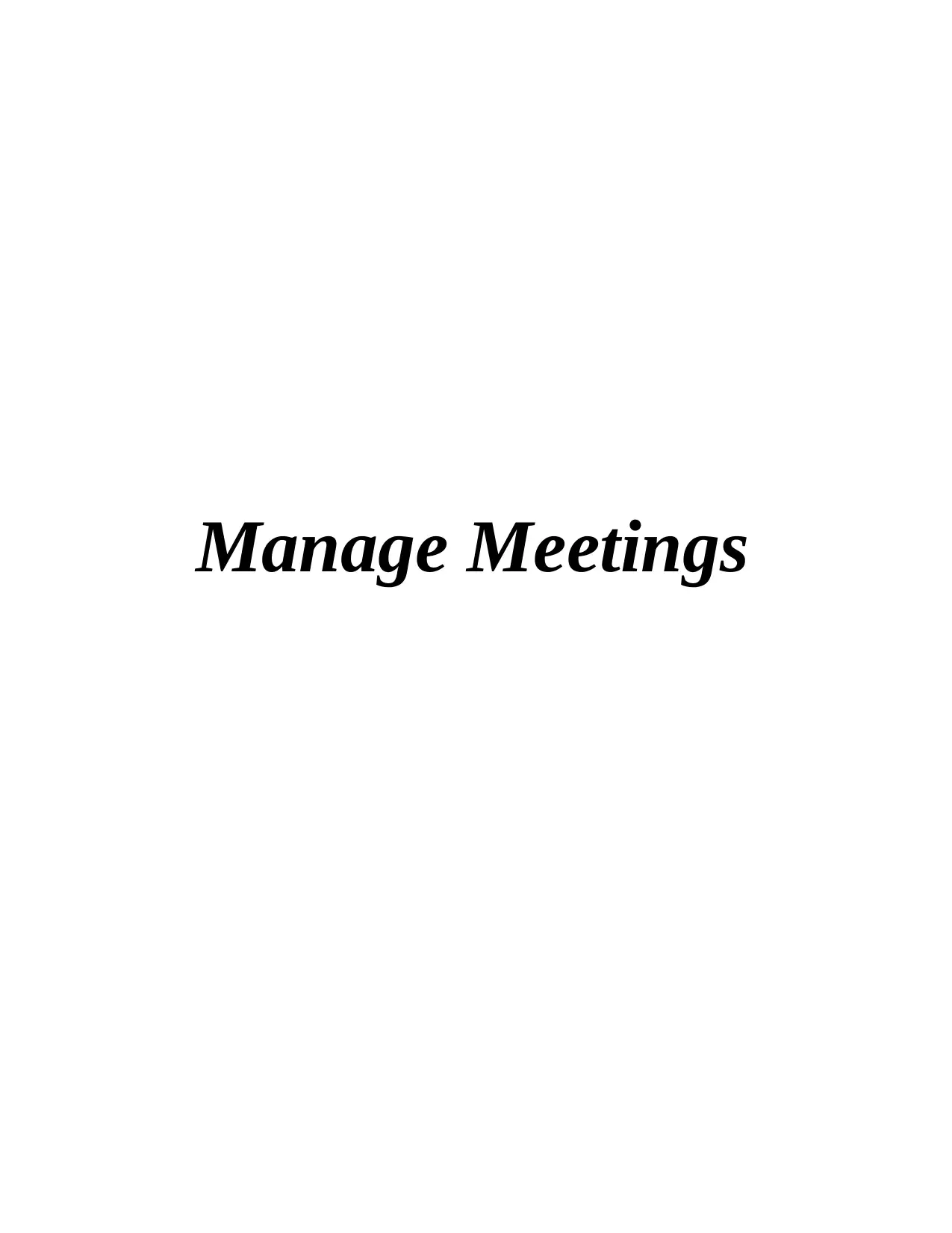
Manage Meetings
Paraphrase This Document
Need a fresh take? Get an instant paraphrase of this document with our AI Paraphraser
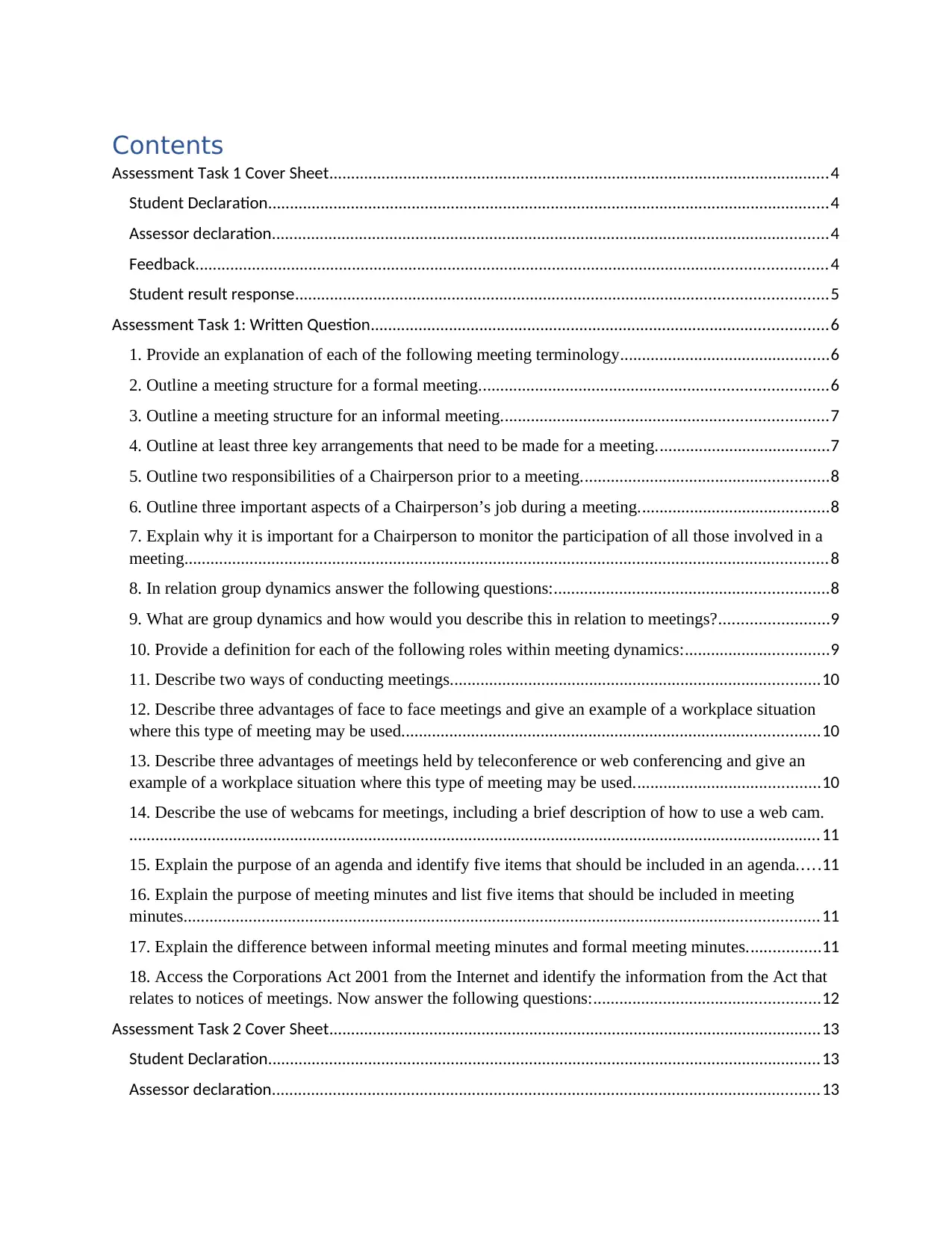
Contents
Assessment Task 1 Cover Sheet...................................................................................................................4
Student Declaration.................................................................................................................................4
Assessor declaration................................................................................................................................4
Feedback.................................................................................................................................................4
Student result response..........................................................................................................................5
Assessment Task 1: Written Question.........................................................................................................6
1. Provide an explanation of each of the following meeting terminology................................................6
2. Outline a meeting structure for a formal meeting................................................................................6
3. Outline a meeting structure for an informal meeting...........................................................................7
4. Outline at least three key arrangements that need to be made for a meeting........................................7
5. Outline two responsibilities of a Chairperson prior to a meeting.........................................................8
6. Outline three important aspects of a Chairperson’s job during a meeting............................................8
7. Explain why it is important for a Chairperson to monitor the participation of all those involved in a
meeting....................................................................................................................................................8
8. In relation group dynamics answer the following questions:...............................................................8
9. What are group dynamics and how would you describe this in relation to meetings?.........................9
10. Provide a definition for each of the following roles within meeting dynamics:.................................9
11. Describe two ways of conducting meetings.....................................................................................10
12. Describe three advantages of face to face meetings and give an example of a workplace situation
where this type of meeting may be used................................................................................................10
13. Describe three advantages of meetings held by teleconference or web conferencing and give an
example of a workplace situation where this type of meeting may be used...........................................10
14. Describe the use of webcams for meetings, including a brief description of how to use a web cam.
...............................................................................................................................................................11
15. Explain the purpose of an agenda and identify five items that should be included in an agenda.....11
16. Explain the purpose of meeting minutes and list five items that should be included in meeting
minutes..................................................................................................................................................11
17. Explain the difference between informal meeting minutes and formal meeting minutes.................11
18. Access the Corporations Act 2001 from the Internet and identify the information from the Act that
relates to notices of meetings. Now answer the following questions:....................................................12
Assessment Task 2 Cover Sheet.................................................................................................................13
Student Declaration...............................................................................................................................13
Assessor declaration..............................................................................................................................13
Assessment Task 1 Cover Sheet...................................................................................................................4
Student Declaration.................................................................................................................................4
Assessor declaration................................................................................................................................4
Feedback.................................................................................................................................................4
Student result response..........................................................................................................................5
Assessment Task 1: Written Question.........................................................................................................6
1. Provide an explanation of each of the following meeting terminology................................................6
2. Outline a meeting structure for a formal meeting................................................................................6
3. Outline a meeting structure for an informal meeting...........................................................................7
4. Outline at least three key arrangements that need to be made for a meeting........................................7
5. Outline two responsibilities of a Chairperson prior to a meeting.........................................................8
6. Outline three important aspects of a Chairperson’s job during a meeting............................................8
7. Explain why it is important for a Chairperson to monitor the participation of all those involved in a
meeting....................................................................................................................................................8
8. In relation group dynamics answer the following questions:...............................................................8
9. What are group dynamics and how would you describe this in relation to meetings?.........................9
10. Provide a definition for each of the following roles within meeting dynamics:.................................9
11. Describe two ways of conducting meetings.....................................................................................10
12. Describe three advantages of face to face meetings and give an example of a workplace situation
where this type of meeting may be used................................................................................................10
13. Describe three advantages of meetings held by teleconference or web conferencing and give an
example of a workplace situation where this type of meeting may be used...........................................10
14. Describe the use of webcams for meetings, including a brief description of how to use a web cam.
...............................................................................................................................................................11
15. Explain the purpose of an agenda and identify five items that should be included in an agenda.....11
16. Explain the purpose of meeting minutes and list five items that should be included in meeting
minutes..................................................................................................................................................11
17. Explain the difference between informal meeting minutes and formal meeting minutes.................11
18. Access the Corporations Act 2001 from the Internet and identify the information from the Act that
relates to notices of meetings. Now answer the following questions:....................................................12
Assessment Task 2 Cover Sheet.................................................................................................................13
Student Declaration...............................................................................................................................13
Assessor declaration..............................................................................................................................13

Feedback...............................................................................................................................................13
Student result response.........................................................................................................................14
Assessment Task 2: Formal meeting project.............................................................................................15
1. Develop meeting agenda....................................................................................................................15
2. Identify leadership topics...................................................................................................................15
3. Confirm the meeting arrangements....................................................................................................15
4. Conduct the meeting..........................................................................................................................15
5. Prepare minute meeting.....................................................................................................................15
6. Update conference program...............................................................................................................15
7. Take screenshot of folders and files...................................................................................................15
8. Send email to staff.............................................................................................................................15
Assessment Task 3 Cover Sheet.................................................................................................................16
Student Declaration...............................................................................................................................16
Assessor declaration..............................................................................................................................16
Feedback...............................................................................................................................................16
Student result response.........................................................................................................................17
Assessment Task 3: Informal meeting project...........................................................................................18
1. Meeting Agenda................................................................................................................................18
2. Email for the staff..............................................................................................................................19
3. Conduct the Meeting.........................................................................................................................20
4. Email for the team.............................................................................................................................20
5. Email for the assessor........................................................................................................................21
REFERENCES..............................................................................................................................................23
Student result response.........................................................................................................................14
Assessment Task 2: Formal meeting project.............................................................................................15
1. Develop meeting agenda....................................................................................................................15
2. Identify leadership topics...................................................................................................................15
3. Confirm the meeting arrangements....................................................................................................15
4. Conduct the meeting..........................................................................................................................15
5. Prepare minute meeting.....................................................................................................................15
6. Update conference program...............................................................................................................15
7. Take screenshot of folders and files...................................................................................................15
8. Send email to staff.............................................................................................................................15
Assessment Task 3 Cover Sheet.................................................................................................................16
Student Declaration...............................................................................................................................16
Assessor declaration..............................................................................................................................16
Feedback...............................................................................................................................................16
Student result response.........................................................................................................................17
Assessment Task 3: Informal meeting project...........................................................................................18
1. Meeting Agenda................................................................................................................................18
2. Email for the staff..............................................................................................................................19
3. Conduct the Meeting.........................................................................................................................20
4. Email for the team.............................................................................................................................20
5. Email for the assessor........................................................................................................................21
REFERENCES..............................................................................................................................................23
⊘ This is a preview!⊘
Do you want full access?
Subscribe today to unlock all pages.

Trusted by 1+ million students worldwide

Assessment Task 1 Cover Sheet
Student Declaration
To be filled out and submitted with assessment responses
I declare that this task is all my own work and I have not cheated or plagiarised the work or colluded
with any other student(s).
I understand that if I am found to have plagiarised, cheated or colluded, action will be taken against
me according to the process explained to me.
I have correctly referenced all resources and reference texts throughout these assessment tasks.
Student name
Student ID number
Student signature
Date
Assessor declaration
I hereby certify that this student has been assessed by me and that the assessment has been carried
out according to the required assessment procedures.
Assessor name
Assessor signature
Date
Assessment outcome S NS DNS Resubmission Y N
Feedback
Student result response
My performance in this assessment task has been discussed and explained to me.
Student Declaration
To be filled out and submitted with assessment responses
I declare that this task is all my own work and I have not cheated or plagiarised the work or colluded
with any other student(s).
I understand that if I am found to have plagiarised, cheated or colluded, action will be taken against
me according to the process explained to me.
I have correctly referenced all resources and reference texts throughout these assessment tasks.
Student name
Student ID number
Student signature
Date
Assessor declaration
I hereby certify that this student has been assessed by me and that the assessment has been carried
out according to the required assessment procedures.
Assessor name
Assessor signature
Date
Assessment outcome S NS DNS Resubmission Y N
Feedback
Student result response
My performance in this assessment task has been discussed and explained to me.
Paraphrase This Document
Need a fresh take? Get an instant paraphrase of this document with our AI Paraphraser
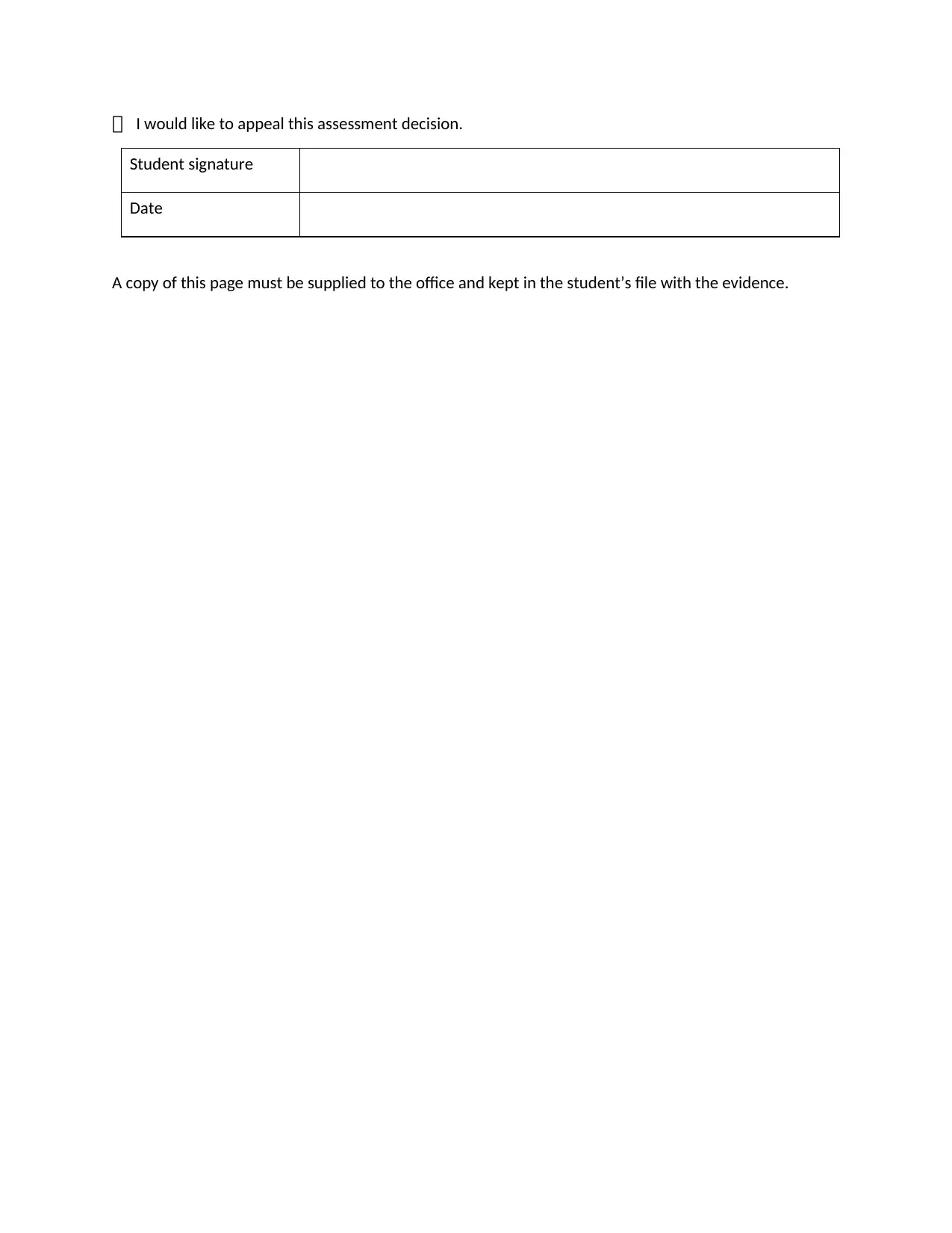
I would like to appeal this assessment decision.
Student signature
Date
A copy of this page must be supplied to the office and kept in the student’s file with the evidence.
Student signature
Date
A copy of this page must be supplied to the office and kept in the student’s file with the evidence.
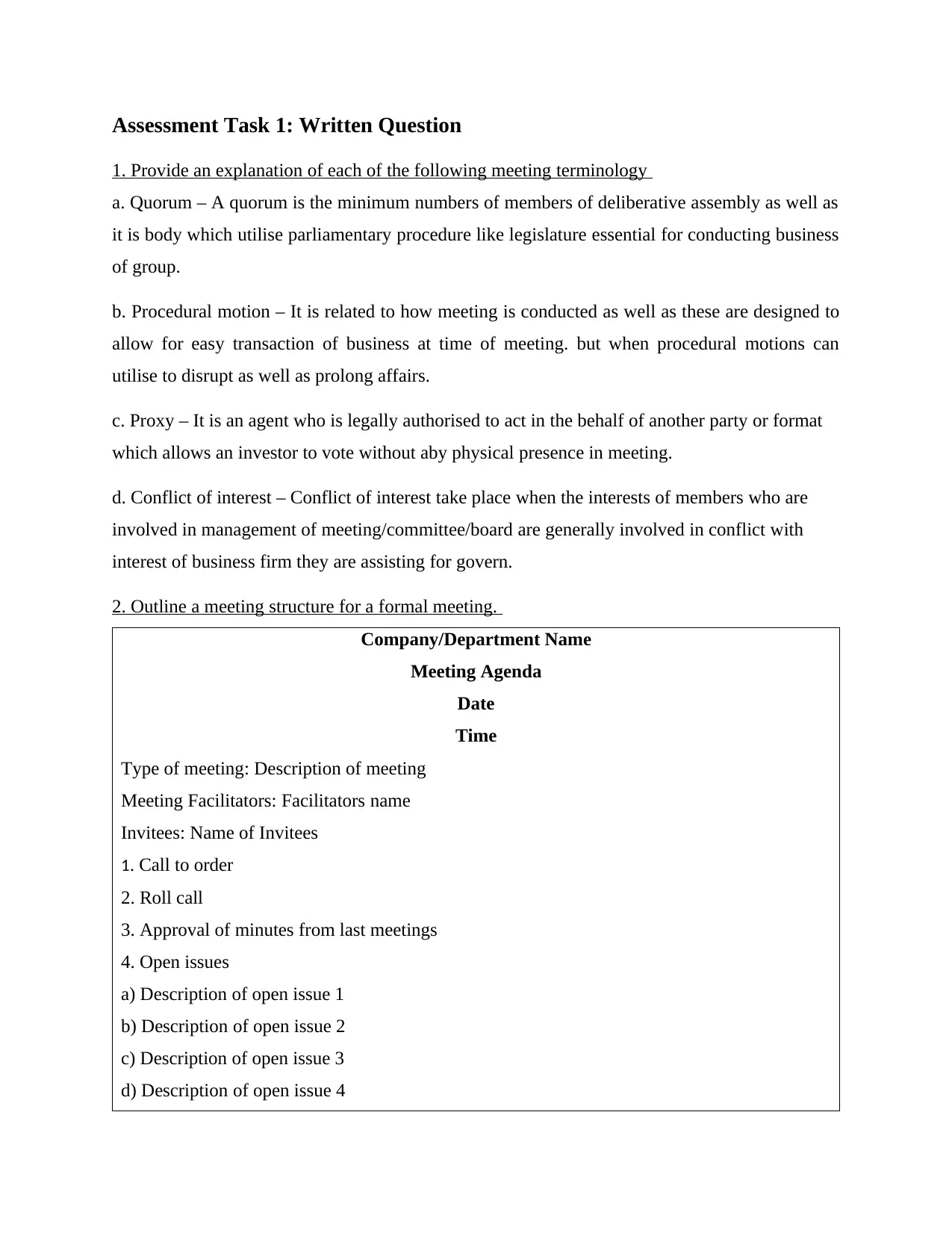
Assessment Task 1: Written Question
1. Provide an explanation of each of the following meeting terminology
a. Quorum – A quorum is the minimum numbers of members of deliberative assembly as well as
it is body which utilise parliamentary procedure like legislature essential for conducting business
of group.
b. Procedural motion – It is related to how meeting is conducted as well as these are designed to
allow for easy transaction of business at time of meeting. but when procedural motions can
utilise to disrupt as well as prolong affairs.
c. Proxy – It is an agent who is legally authorised to act in the behalf of another party or format
which allows an investor to vote without aby physical presence in meeting.
d. Conflict of interest – Conflict of interest take place when the interests of members who are
involved in management of meeting/committee/board are generally involved in conflict with
interest of business firm they are assisting for govern.
2. Outline a meeting structure for a formal meeting.
Company/Department Name
Meeting Agenda
Date
Time
Type of meeting: Description of meeting
Meeting Facilitators: Facilitators name
Invitees: Name of Invitees
1. Call to order
2. Roll call
3. Approval of minutes from last meetings
4. Open issues
a) Description of open issue 1
b) Description of open issue 2
c) Description of open issue 3
d) Description of open issue 4
1. Provide an explanation of each of the following meeting terminology
a. Quorum – A quorum is the minimum numbers of members of deliberative assembly as well as
it is body which utilise parliamentary procedure like legislature essential for conducting business
of group.
b. Procedural motion – It is related to how meeting is conducted as well as these are designed to
allow for easy transaction of business at time of meeting. but when procedural motions can
utilise to disrupt as well as prolong affairs.
c. Proxy – It is an agent who is legally authorised to act in the behalf of another party or format
which allows an investor to vote without aby physical presence in meeting.
d. Conflict of interest – Conflict of interest take place when the interests of members who are
involved in management of meeting/committee/board are generally involved in conflict with
interest of business firm they are assisting for govern.
2. Outline a meeting structure for a formal meeting.
Company/Department Name
Meeting Agenda
Date
Time
Type of meeting: Description of meeting
Meeting Facilitators: Facilitators name
Invitees: Name of Invitees
1. Call to order
2. Roll call
3. Approval of minutes from last meetings
4. Open issues
a) Description of open issue 1
b) Description of open issue 2
c) Description of open issue 3
d) Description of open issue 4
⊘ This is a preview!⊘
Do you want full access?
Subscribe today to unlock all pages.

Trusted by 1+ million students worldwide
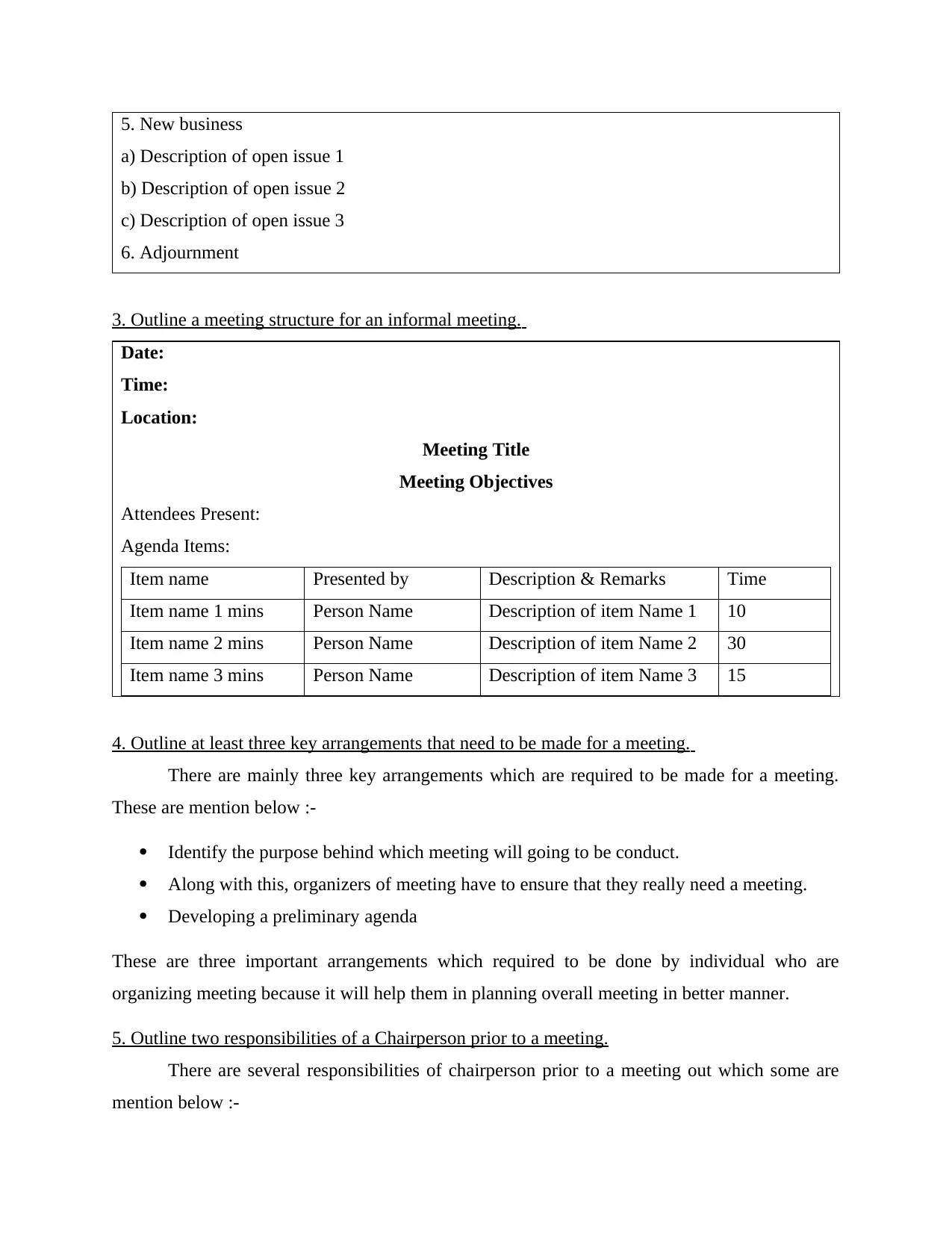
5. New business
a) Description of open issue 1
b) Description of open issue 2
c) Description of open issue 3
6. Adjournment
3. Outline a meeting structure for an informal meeting.
Date:
Time:
Location:
Meeting Title
Meeting Objectives
Attendees Present:
Agenda Items:
Item name Presented by Description & Remarks Time
Item name 1 mins Person Name Description of item Name 1 10
Item name 2 mins Person Name Description of item Name 2 30
Item name 3 mins Person Name Description of item Name 3 15
4. Outline at least three key arrangements that need to be made for a meeting.
There are mainly three key arrangements which are required to be made for a meeting.
These are mention below :-
Identify the purpose behind which meeting will going to be conduct.
Along with this, organizers of meeting have to ensure that they really need a meeting.
Developing a preliminary agenda
These are three important arrangements which required to be done by individual who are
organizing meeting because it will help them in planning overall meeting in better manner.
5. Outline two responsibilities of a Chairperson prior to a meeting.
There are several responsibilities of chairperson prior to a meeting out which some are
mention below :-
a) Description of open issue 1
b) Description of open issue 2
c) Description of open issue 3
6. Adjournment
3. Outline a meeting structure for an informal meeting.
Date:
Time:
Location:
Meeting Title
Meeting Objectives
Attendees Present:
Agenda Items:
Item name Presented by Description & Remarks Time
Item name 1 mins Person Name Description of item Name 1 10
Item name 2 mins Person Name Description of item Name 2 30
Item name 3 mins Person Name Description of item Name 3 15
4. Outline at least three key arrangements that need to be made for a meeting.
There are mainly three key arrangements which are required to be made for a meeting.
These are mention below :-
Identify the purpose behind which meeting will going to be conduct.
Along with this, organizers of meeting have to ensure that they really need a meeting.
Developing a preliminary agenda
These are three important arrangements which required to be done by individual who are
organizing meeting because it will help them in planning overall meeting in better manner.
5. Outline two responsibilities of a Chairperson prior to a meeting.
There are several responsibilities of chairperson prior to a meeting out which some are
mention below :-
Paraphrase This Document
Need a fresh take? Get an instant paraphrase of this document with our AI Paraphraser

Define the meeting objective and decide if this is the best way of addressing issues in
effectual manner.
To make sure that key contributors and those with authority to make decisions are invited
for attending. If too few are available then meeting has to be postpone or cancel.
6. Outline three important aspects of a Chairperson’s job during a meeting.
There are some important aspects of chairperson’s have to perform during meeting these
are as follows :-
Understand all the necessary preparation of meetings.
Ensure that meeting will be related to topic and has to be conduct in proper manner
Listen to the opinions of each and every person.
7. Explain why it is important for a Chairperson to monitor the participation of all those involved
in a meeting.
It is important for chairperson to monitor participation of each and every individual who
are involve in meeting because this will help in gaining effective outcomes. Along with this, it
also makes sure that decisions will be taken in better manner.
8. In relation group dynamics answer the following questions:
a. Explain how, in the role of a Chairperson, you would manage someone who is dominating the
meeting.
Dominating behaviour is not required in meeting so it is important to make sure that
behaviour of every individual has to be manage in proper manner. excitement of anyone will not
going to be tolerate in meeting.
b. Explain how in the role of a Chairperson you would manage someone who is too shy to
contribute to a meeting.
Contribution of each and every individual in meeting is important as well as it is essential
for chairperson to make person comfortable and encourage them for proper contribution.
Because there contribution may result in better decision making and gaining effective outcomes.
c. Explain how in the role of a Chairperson you would manage two people having a private
conversation within a meeting.
effectual manner.
To make sure that key contributors and those with authority to make decisions are invited
for attending. If too few are available then meeting has to be postpone or cancel.
6. Outline three important aspects of a Chairperson’s job during a meeting.
There are some important aspects of chairperson’s have to perform during meeting these
are as follows :-
Understand all the necessary preparation of meetings.
Ensure that meeting will be related to topic and has to be conduct in proper manner
Listen to the opinions of each and every person.
7. Explain why it is important for a Chairperson to monitor the participation of all those involved
in a meeting.
It is important for chairperson to monitor participation of each and every individual who
are involve in meeting because this will help in gaining effective outcomes. Along with this, it
also makes sure that decisions will be taken in better manner.
8. In relation group dynamics answer the following questions:
a. Explain how, in the role of a Chairperson, you would manage someone who is dominating the
meeting.
Dominating behaviour is not required in meeting so it is important to make sure that
behaviour of every individual has to be manage in proper manner. excitement of anyone will not
going to be tolerate in meeting.
b. Explain how in the role of a Chairperson you would manage someone who is too shy to
contribute to a meeting.
Contribution of each and every individual in meeting is important as well as it is essential
for chairperson to make person comfortable and encourage them for proper contribution.
Because there contribution may result in better decision making and gaining effective outcomes.
c. Explain how in the role of a Chairperson you would manage two people having a private
conversation within a meeting.
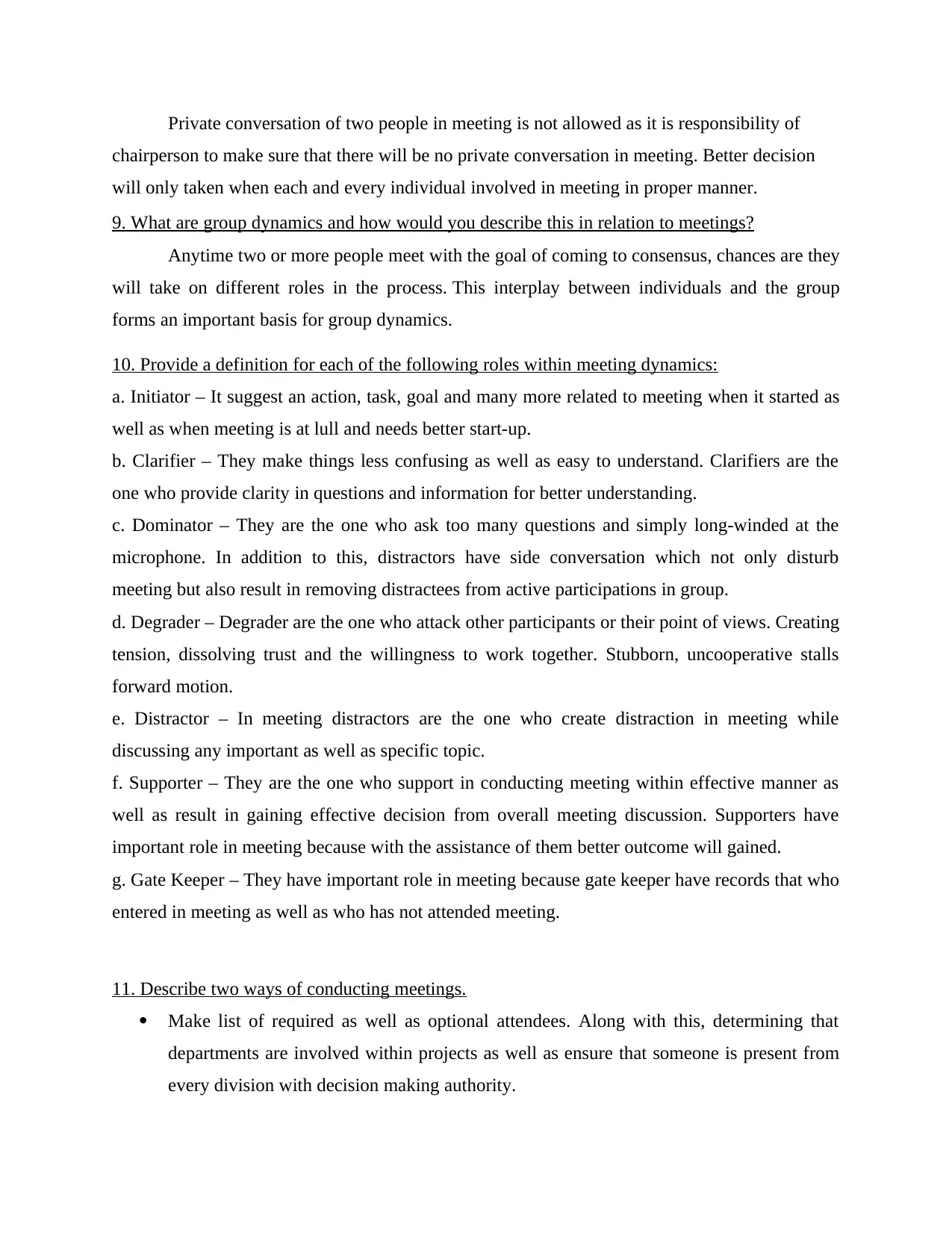
Private conversation of two people in meeting is not allowed as it is responsibility of
chairperson to make sure that there will be no private conversation in meeting. Better decision
will only taken when each and every individual involved in meeting in proper manner.
9. What are group dynamics and how would you describe this in relation to meetings?
Anytime two or more people meet with the goal of coming to consensus, chances are they
will take on different roles in the process. This interplay between individuals and the group
forms an important basis for group dynamics.
10. Provide a definition for each of the following roles within meeting dynamics:
a. Initiator – It suggest an action, task, goal and many more related to meeting when it started as
well as when meeting is at lull and needs better start-up.
b. Clarifier – They make things less confusing as well as easy to understand. Clarifiers are the
one who provide clarity in questions and information for better understanding.
c. Dominator – They are the one who ask too many questions and simply long-winded at the
microphone. In addition to this, distractors have side conversation which not only disturb
meeting but also result in removing distractees from active participations in group.
d. Degrader – Degrader are the one who attack other participants or their point of views. Creating
tension, dissolving trust and the willingness to work together. Stubborn, uncooperative stalls
forward motion.
e. Distractor – In meeting distractors are the one who create distraction in meeting while
discussing any important as well as specific topic.
f. Supporter – They are the one who support in conducting meeting within effective manner as
well as result in gaining effective decision from overall meeting discussion. Supporters have
important role in meeting because with the assistance of them better outcome will gained.
g. Gate Keeper – They have important role in meeting because gate keeper have records that who
entered in meeting as well as who has not attended meeting.
11. Describe two ways of conducting meetings.
Make list of required as well as optional attendees. Along with this, determining that
departments are involved within projects as well as ensure that someone is present from
every division with decision making authority.
chairperson to make sure that there will be no private conversation in meeting. Better decision
will only taken when each and every individual involved in meeting in proper manner.
9. What are group dynamics and how would you describe this in relation to meetings?
Anytime two or more people meet with the goal of coming to consensus, chances are they
will take on different roles in the process. This interplay between individuals and the group
forms an important basis for group dynamics.
10. Provide a definition for each of the following roles within meeting dynamics:
a. Initiator – It suggest an action, task, goal and many more related to meeting when it started as
well as when meeting is at lull and needs better start-up.
b. Clarifier – They make things less confusing as well as easy to understand. Clarifiers are the
one who provide clarity in questions and information for better understanding.
c. Dominator – They are the one who ask too many questions and simply long-winded at the
microphone. In addition to this, distractors have side conversation which not only disturb
meeting but also result in removing distractees from active participations in group.
d. Degrader – Degrader are the one who attack other participants or their point of views. Creating
tension, dissolving trust and the willingness to work together. Stubborn, uncooperative stalls
forward motion.
e. Distractor – In meeting distractors are the one who create distraction in meeting while
discussing any important as well as specific topic.
f. Supporter – They are the one who support in conducting meeting within effective manner as
well as result in gaining effective decision from overall meeting discussion. Supporters have
important role in meeting because with the assistance of them better outcome will gained.
g. Gate Keeper – They have important role in meeting because gate keeper have records that who
entered in meeting as well as who has not attended meeting.
11. Describe two ways of conducting meetings.
Make list of required as well as optional attendees. Along with this, determining that
departments are involved within projects as well as ensure that someone is present from
every division with decision making authority.
⊘ This is a preview!⊘
Do you want full access?
Subscribe today to unlock all pages.

Trusted by 1+ million students worldwide
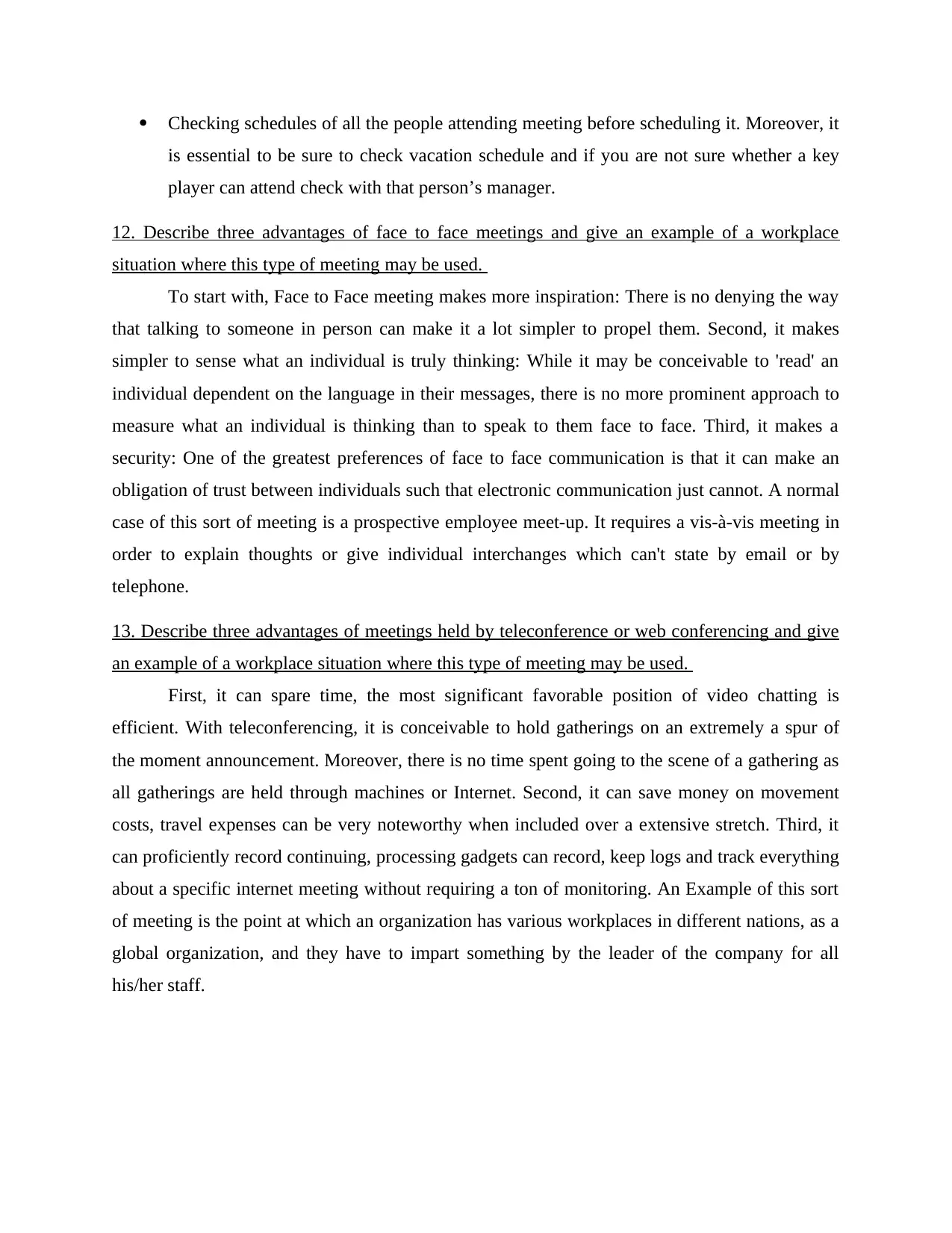
Checking schedules of all the people attending meeting before scheduling it. Moreover, it
is essential to be sure to check vacation schedule and if you are not sure whether a key
player can attend check with that person’s manager.
12. Describe three advantages of face to face meetings and give an example of a workplace
situation where this type of meeting may be used.
To start with, Face to Face meeting makes more inspiration: There is no denying the way
that talking to someone in person can make it a lot simpler to propel them. Second, it makes
simpler to sense what an individual is truly thinking: While it may be conceivable to 'read' an
individual dependent on the language in their messages, there is no more prominent approach to
measure what an individual is thinking than to speak to them face to face. Third, it makes a
security: One of the greatest preferences of face to face communication is that it can make an
obligation of trust between individuals such that electronic communication just cannot. A normal
case of this sort of meeting is a prospective employee meet-up. It requires a vis-à-vis meeting in
order to explain thoughts or give individual interchanges which can't state by email or by
telephone.
13. Describe three advantages of meetings held by teleconference or web conferencing and give
an example of a workplace situation where this type of meeting may be used.
First, it can spare time, the most significant favorable position of video chatting is
efficient. With teleconferencing, it is conceivable to hold gatherings on an extremely a spur of
the moment announcement. Moreover, there is no time spent going to the scene of a gathering as
all gatherings are held through machines or Internet. Second, it can save money on movement
costs, travel expenses can be very noteworthy when included over a extensive stretch. Third, it
can proficiently record continuing, processing gadgets can record, keep logs and track everything
about a specific internet meeting without requiring a ton of monitoring. An Example of this sort
of meeting is the point at which an organization has various workplaces in different nations, as a
global organization, and they have to impart something by the leader of the company for all
his/her staff.
is essential to be sure to check vacation schedule and if you are not sure whether a key
player can attend check with that person’s manager.
12. Describe three advantages of face to face meetings and give an example of a workplace
situation where this type of meeting may be used.
To start with, Face to Face meeting makes more inspiration: There is no denying the way
that talking to someone in person can make it a lot simpler to propel them. Second, it makes
simpler to sense what an individual is truly thinking: While it may be conceivable to 'read' an
individual dependent on the language in their messages, there is no more prominent approach to
measure what an individual is thinking than to speak to them face to face. Third, it makes a
security: One of the greatest preferences of face to face communication is that it can make an
obligation of trust between individuals such that electronic communication just cannot. A normal
case of this sort of meeting is a prospective employee meet-up. It requires a vis-à-vis meeting in
order to explain thoughts or give individual interchanges which can't state by email or by
telephone.
13. Describe three advantages of meetings held by teleconference or web conferencing and give
an example of a workplace situation where this type of meeting may be used.
First, it can spare time, the most significant favorable position of video chatting is
efficient. With teleconferencing, it is conceivable to hold gatherings on an extremely a spur of
the moment announcement. Moreover, there is no time spent going to the scene of a gathering as
all gatherings are held through machines or Internet. Second, it can save money on movement
costs, travel expenses can be very noteworthy when included over a extensive stretch. Third, it
can proficiently record continuing, processing gadgets can record, keep logs and track everything
about a specific internet meeting without requiring a ton of monitoring. An Example of this sort
of meeting is the point at which an organization has various workplaces in different nations, as a
global organization, and they have to impart something by the leader of the company for all
his/her staff.
Paraphrase This Document
Need a fresh take? Get an instant paraphrase of this document with our AI Paraphraser
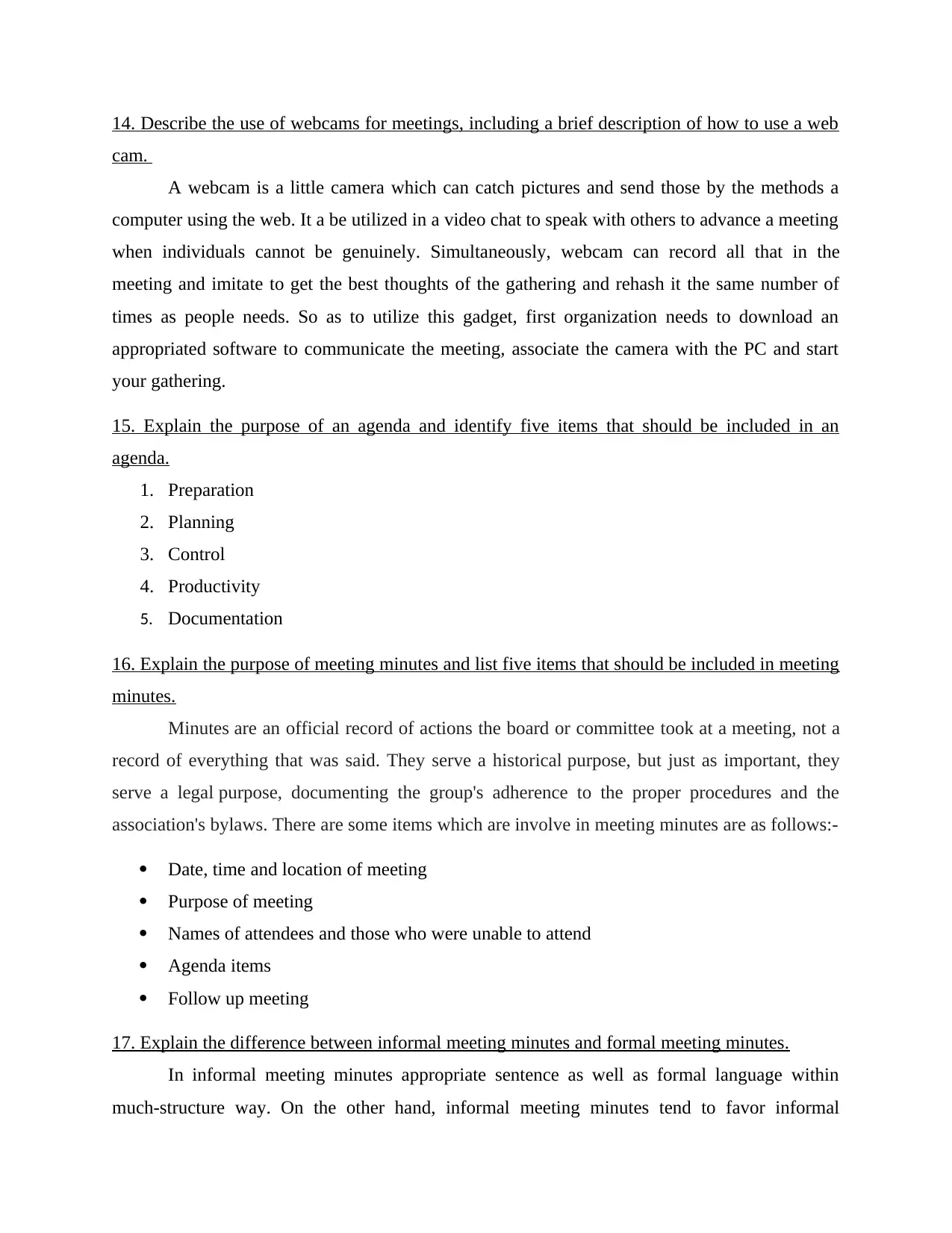
14. Describe the use of webcams for meetings, including a brief description of how to use a web
cam.
A webcam is a little camera which can catch pictures and send those by the methods a
computer using the web. It a be utilized in a video chat to speak with others to advance a meeting
when individuals cannot be genuinely. Simultaneously, webcam can record all that in the
meeting and imitate to get the best thoughts of the gathering and rehash it the same number of
times as people needs. So as to utilize this gadget, first organization needs to download an
appropriated software to communicate the meeting, associate the camera with the PC and start
your gathering.
15. Explain the purpose of an agenda and identify five items that should be included in an
agenda.
1. Preparation
2. Planning
3. Control
4. Productivity
5. Documentation
16. Explain the purpose of meeting minutes and list five items that should be included in meeting
minutes.
Minutes are an official record of actions the board or committee took at a meeting, not a
record of everything that was said. They serve a historical purpose, but just as important, they
serve a legal purpose, documenting the group's adherence to the proper procedures and the
association's bylaws. There are some items which are involve in meeting minutes are as follows:-
Date, time and location of meeting
Purpose of meeting
Names of attendees and those who were unable to attend
Agenda items
Follow up meeting
17. Explain the difference between informal meeting minutes and formal meeting minutes.
In informal meeting minutes appropriate sentence as well as formal language within
much-structure way. On the other hand, informal meeting minutes tend to favor informal
cam.
A webcam is a little camera which can catch pictures and send those by the methods a
computer using the web. It a be utilized in a video chat to speak with others to advance a meeting
when individuals cannot be genuinely. Simultaneously, webcam can record all that in the
meeting and imitate to get the best thoughts of the gathering and rehash it the same number of
times as people needs. So as to utilize this gadget, first organization needs to download an
appropriated software to communicate the meeting, associate the camera with the PC and start
your gathering.
15. Explain the purpose of an agenda and identify five items that should be included in an
agenda.
1. Preparation
2. Planning
3. Control
4. Productivity
5. Documentation
16. Explain the purpose of meeting minutes and list five items that should be included in meeting
minutes.
Minutes are an official record of actions the board or committee took at a meeting, not a
record of everything that was said. They serve a historical purpose, but just as important, they
serve a legal purpose, documenting the group's adherence to the proper procedures and the
association's bylaws. There are some items which are involve in meeting minutes are as follows:-
Date, time and location of meeting
Purpose of meeting
Names of attendees and those who were unable to attend
Agenda items
Follow up meeting
17. Explain the difference between informal meeting minutes and formal meeting minutes.
In informal meeting minutes appropriate sentence as well as formal language within
much-structure way. On the other hand, informal meeting minutes tend to favor informal
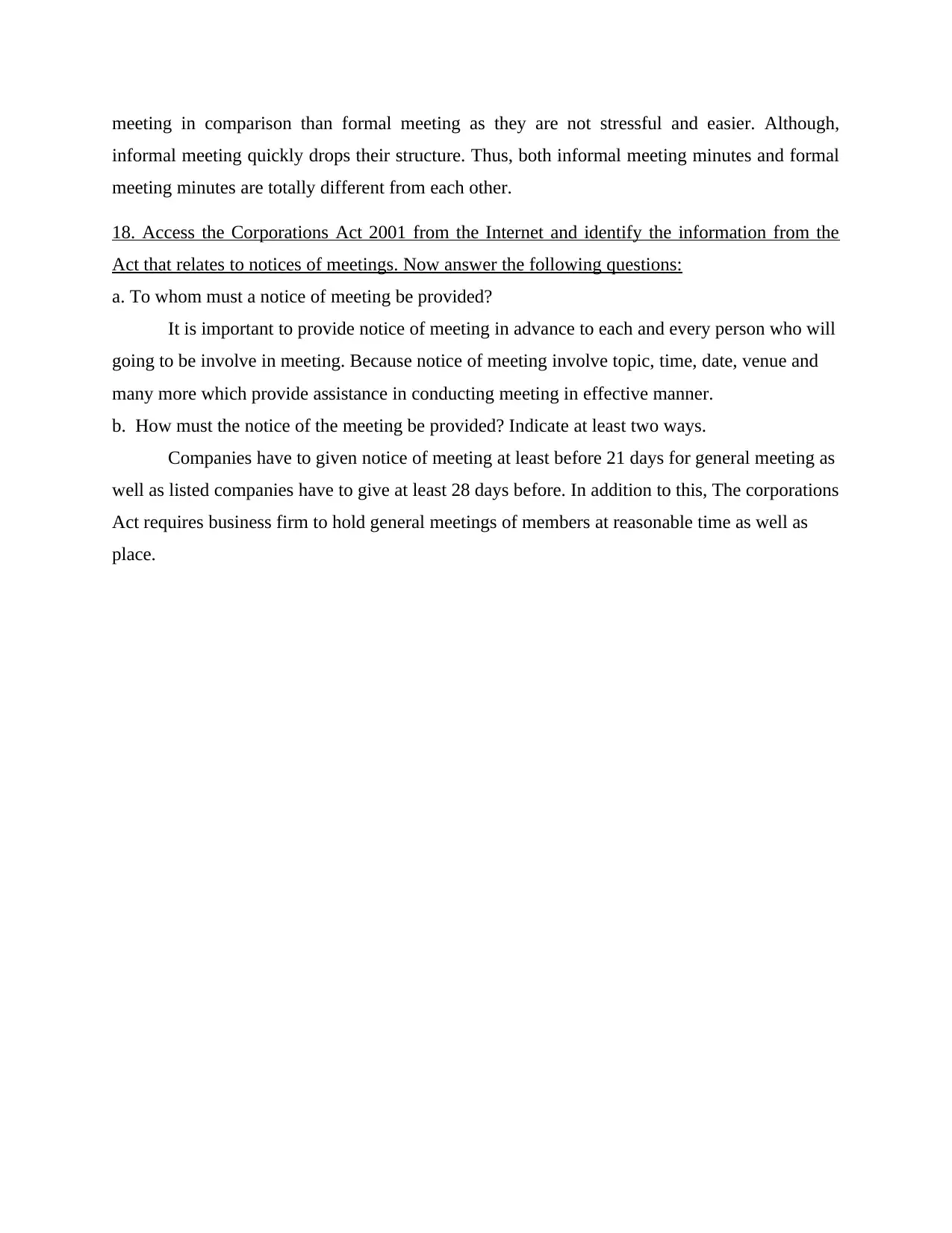
meeting in comparison than formal meeting as they are not stressful and easier. Although,
informal meeting quickly drops their structure. Thus, both informal meeting minutes and formal
meeting minutes are totally different from each other.
18. Access the Corporations Act 2001 from the Internet and identify the information from the
Act that relates to notices of meetings. Now answer the following questions:
a. To whom must a notice of meeting be provided?
It is important to provide notice of meeting in advance to each and every person who will
going to be involve in meeting. Because notice of meeting involve topic, time, date, venue and
many more which provide assistance in conducting meeting in effective manner.
b. How must the notice of the meeting be provided? Indicate at least two ways.
Companies have to given notice of meeting at least before 21 days for general meeting as
well as listed companies have to give at least 28 days before. In addition to this, The corporations
Act requires business firm to hold general meetings of members at reasonable time as well as
place.
informal meeting quickly drops their structure. Thus, both informal meeting minutes and formal
meeting minutes are totally different from each other.
18. Access the Corporations Act 2001 from the Internet and identify the information from the
Act that relates to notices of meetings. Now answer the following questions:
a. To whom must a notice of meeting be provided?
It is important to provide notice of meeting in advance to each and every person who will
going to be involve in meeting. Because notice of meeting involve topic, time, date, venue and
many more which provide assistance in conducting meeting in effective manner.
b. How must the notice of the meeting be provided? Indicate at least two ways.
Companies have to given notice of meeting at least before 21 days for general meeting as
well as listed companies have to give at least 28 days before. In addition to this, The corporations
Act requires business firm to hold general meetings of members at reasonable time as well as
place.
⊘ This is a preview!⊘
Do you want full access?
Subscribe today to unlock all pages.

Trusted by 1+ million students worldwide
1 out of 24
Related Documents
Your All-in-One AI-Powered Toolkit for Academic Success.
+13062052269
info@desklib.com
Available 24*7 on WhatsApp / Email
![[object Object]](/_next/static/media/star-bottom.7253800d.svg)
Unlock your academic potential
Copyright © 2020–2025 A2Z Services. All Rights Reserved. Developed and managed by ZUCOL.

![Manage Meetings (BSBADM502) Assignment - [University Name]](/_next/image/?url=https%3A%2F%2Fdesklib.com%2Fmedia%2Fimages%2Ffk%2F730418eb50384ea0af779bba77d0b98d.jpg&w=256&q=75)


